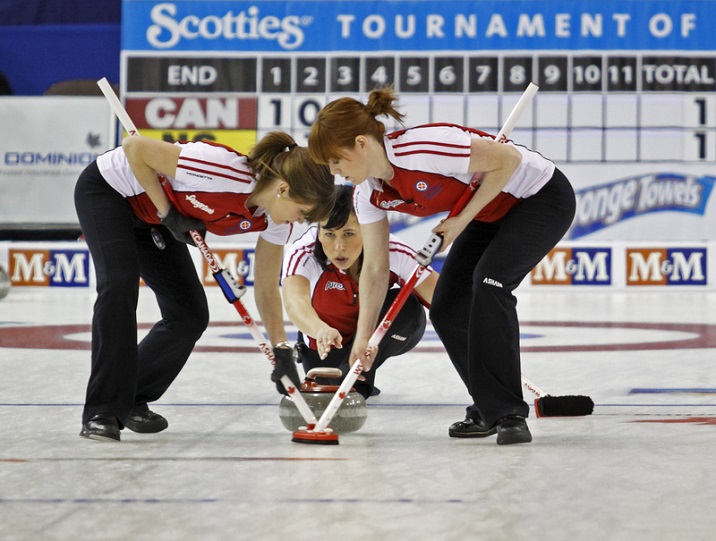
Curling - Quick Guide
Curling - Overview
Curling is a sport that is played on an ice platform and the best thing about Curling is that it can be enjoyed by any age group. It has many names. Some call it chess set on ice, whereas some call it a hybrid of bowling, but the perfect synonym will be shuffleboard.
The objective of this sport is to slide stones into the concentric circles made on an ice base. Two teams each consisting of four players compete in the sport. Each team having eight stone needs to push their stones towards the circle and should position them as close as possible. More close is the stone near to the circle area, higher will be the point. At the end of the session, the team having highest point becomes the winner.

A Brief History of Curling
The sport is believed to have originated from Scotland during the 16th century. The people of Scotland used to play with various stones on the frozen pond. The Grand Caledonian club formulated the rules for Curling during the late 1838. In 1843, the name of the club was changed to Royal Caledonian Curling Club.
The peek development in the sport took place in the 20th century. In 1924, curling was introduced for the first time in the Winter Olympics in Chamonix. Later it was dropped from the Olympics and again re-introduced as a demonstration sport in lake placid in the year 1932. Finally, in 1998, it was given official Winter Olympic sport status and since then it has been played in both men and women category.
In February 2002, International Olympic Committee named it as the official sport. The first award for the sport was given to the 1932 demonstration match in which, Great Britain and Ireland bagged gold medals whereas Sweden and France won two silvers and one bronze medals respectively.
Participating Countries
The governing body for curling competition is The World Curling Federation (WCF). 26+ nations are taking active participation in this sport through various tournaments and championships. The list of countries includes Australia, Canada, China, Denmark, Japan, Spain, Russia and United States etc. The participant nations are often called as curlers.
Canada is the country, where worlds 90% of the curling people live. Norway and France have improved their rankings considerably in mens curling category while Russia and Japan showing their best in womens category.
The rankings of different countries are done by taking their performance of last six seasons into account. In Winter Olympic Games, the maximum points that can be awarded to the first rank holder is 480 whereas; for that of World Curling Championships, the maximum point is 240.
According to the latest ratings (2013-2014 season), the top 5 countries in mens category are −
- Canada
- Sweden
- Scotland and Great Britain
- Norway
- Switzerland
Similarly, the list of top five countries in womens category is as follows −
- Canada
- Sweden
- Switzerland
- Scotland and Great Britain
- China
Curling - Equipment
Those who play Curling admire it as one of the most fascinating sports invented ever. The craziness of this sport can be seen much in the ice countries. It is often played by all age groups because the best thing about this sport is that it requires no strong physique; rather it requires only good strategy. But before moving to the playing strategies involved in Curling, let us have a look upon the equipment that we are going to require while playing this sport.
Curling requires three basic equipment −
- Curling sheet
- Curling broom
- Curling stone
In addition to the above equipment, the list includes shoes, gloves, and protection equipment.
Curling Sheet
Curling needs a flat and smooth surface to provide good friction. The surface is a rectangular sheet having dimensions 45m5m, as decided by the World Curling Federation. Due to the elongated shape, multiple matches can be played simultaneously by laying more than one surface.
A back line of 1.83m is drawn at the back of the house. It is parallel to tee line which is drawn bearing a length of 4.3-4.75 m. A line that passes exactly through the center of the sheet is known as center line. Target house is present at the intersection of this tee line and center line. Apart from the central circle, three other circles are also printed with different colors.
To get points, the stones must touch the outer circle. The position of two hog lines are at a distance of 6.40m on the either side of the center. The positions of the hacks are at 12 feet behind the center. The ice are manufactured and taken care of by different manufacturers.
The curling of the stone depends upon the pebble on the surface. More is the pebble on the surface, more the stone curls after hitting it on the surface. So the ice manufacturers prepare pebbles on the ice surface and re-pebble it in case of wear and tear. The formation of pebble is done by spraying water droplets on the ice surface.
Curling Broom
A curling broom is a kind of brush that serves the following two purposes −
- Balancing the stones while delivering
- Sweep the path through which the stone moves.
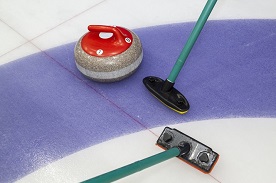
Earlier curling brooms were made up of fabric. Some were also made up of horsehair or hog hair but with the passage of time, modern curling brooms came into the market.
Nowadays, the curling brooms have the structure of a hollow tube which are made up with fiber glass or carbon fiber.
The reason of using hollow tubes is that they are lighter than wooden brooms and they provide a good downward force to the handle of the stone but some are accusing the modern brooms giving an unfair advantage to the players in the match.
Curling Stones
It is nothing but a granite stone bearing a weight of 38-44 pounds with a maximum circumference of 36 inches. The height is maintained usually at 4.5 inches. All these standards are maintained under the guidance of world curling federation.
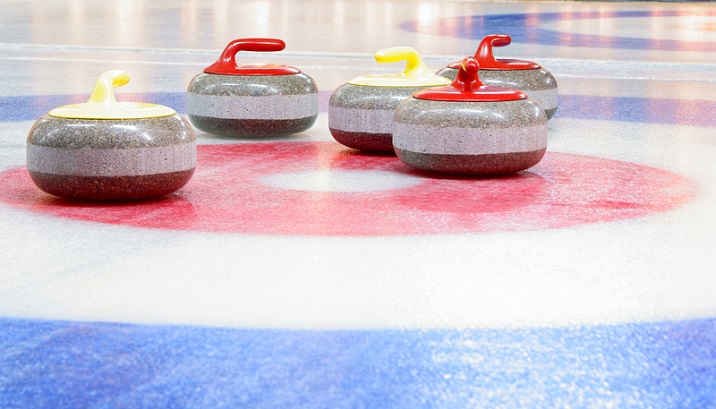
The lower part of the ring only comes in contact with the surface and it is called as running surface. The inner part of the ring is having a shape of concave and is hollow. The purpose is to clear the ice while sailing on the surface. From the figure above we can clearly see a handle attached to it. This is bolted at the center of the stone and is used for gripping purpose.
Curling Shoes
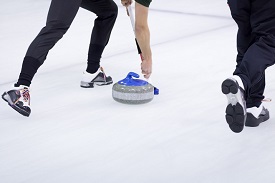
Curling shoes is different in the construction because of having dissimilar soles on both. One is known as slider shoe, whereas; other is known as gripper shoe.
As the name suggests, the slider shoe is used to slide on the ice surface and gripper shoe is use to hack the surface. It is generally worn by the thrower on the foot which he is going to hack the surface.
Curling shoes also have a rubber coating to protect them from wear and tear while moving on rough ice surface.
How to play Curling?
Starting the Match
Two teams each having eight stones, play alternatively. In each trial, the team tries to push their stones nearer to the button as close as possible. At the end of successful accumulation of 16 stones near the centre area, the scoring procedure begins. The team having highest score is declared as winner. However, if it is a tie, then the two teams again compete until a winner is declared.
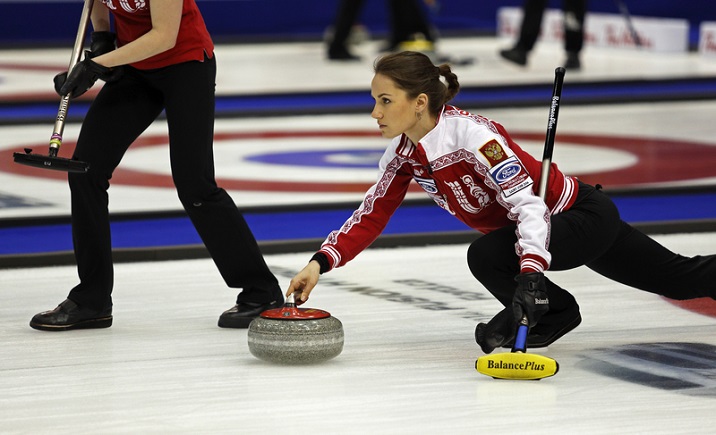
Each match varies in between eight ends to ten ends depending upon the level of match. After the end of ten ends, the teams are given two 60 seconds time out. A 73-minute timeslot is allocated to each team to complete their throw of 8 stones. In case extra ends are required, the team may be granted additional 10 minutes with a 60 second time out.
Delivery
The process involving sliding the stones on the sheet is known as delivery. Rather than physical power, it requires tactics to successfully slide the stone towards its destination. The captain of the team is known as skip. He takes the charge of making decision about the turn, weight, and even the line of the stone.
Weight − The velocity of the stone is known as weight. It directly depends upon the leg drive of the delivery whereas the arm has nothing to do in it.
Turn − Turn is the term associated with the curling of the stone. The direction in which the stone is initially thrown, irrespective of its curling path, is called its line.
Communications about the weight, line, and turn among the players is allowed and they do it by tapping the broom on the ice.
Before delivering the stone, the bottom of the stone and the path through which it is going to travel is cleaned with the help of broom if necessary because any stones or obstacles on the path may change the desired trajectory of the stone. The intrusion of foreign objects is often termed as pick up or pick. Hence proper cleaning is necessary.

The role of every person changes in a rotational basis. The position of the skip is usually behind the button. He gives the direction about choosing the weight, line and turn of the curl. The person who throws the stone will be present behind the hack. The role of remaining players will be to clean the traveling path of the stone with brooms.
The thrower stumps his gripper shoe near the hack. Then with a slightest backward motion, he pushes the stones outwards moving the slider foot ahead of the gripper foot. It is a usual practice to put your right leg against the left of the hack, if you are a right handed curler and vice versa.
Just before the stone crosses the hog line, the stone is released. Unless it clears the hog line completely, it will be removed from the match. To keep track on the illegal throw eye on the hog sensor is used. It can detect the illegal manipulation of the handle while throwing and indicates light accordingly. The green light indicates for legal throw whereas red light indicates illegal attempt.
Sweeping
Even after the pushing of the stone, two players continue to sweep the path of trajectory in advance. Sweeping has the following reasons −
- It reduces the frictional loss between the stone and its surface.
- The process minimizes the amount of curl.
- It ensures that the trajectory path is free from any unwanted obstacles.
When the stones start losing their kinetic velocity, they tend to curl more. Keeping in mind these facts, sweeping is done much early to provide an elongated and straight path.
Some basic facts that one player should know regarding sweeping are −
The player should be able to judge the necessity of sweeping well in advance. Because sometimes too much sweeping can give too much weight to the stone and it can travel to an undesirable direction.
The sweeping player should inform about the weight of the stone to the skip at every small fraction of time. It makes the skipper able to decide the line of the stone.
A sweeper should stand at that side of the stone in which he is strong at giving push.
He should have the idea about where to sweep the stone because there are some invalid lines or areas in which if your stone travels, then it will yield you no point.
Two persons are not allowed to sweep the teams stone beyond the tee line is not allowed by two persons. Only one person may be allowed.
Beyond the tee line, one player from the opponent team may sweep your stone. This is where there is a chance that the stone may deviate from its destination.
Burning a Stone
Occasionally players touch the stones with their body or broom by accident. This is known as burning a stone. Any of the following three steps can be taken after burning a stone −
- Positioning the disturbed stones as they finish up after the touch
- Positioning them as they were present prior to the touch
- Completely remove the touched stone from the match
If a stone is not in a delivery position and the player touches it, then it does not go under this category; but if the touching impacts the position of the stationary stone, then it is a matter of infraction. Skippers often take the advantage of this rule and use this to indicate their teammates the next stone that they should sweep.
Curling - Types of Shots
Curling is not a sport of physical power, rather it is a sport that only needs good strategy and statistics. Different types of shooting strategies are followed to push the stone to its destination. Lets have a look at them.
Guard Shots
To protect the shot rock, the players throw the guards into the free zone.
The stone which are close to the buttons are known as shot rock.
Teams often use this type of shots to make the opponent team difficult in playing their shots.
The position of the center guard is at the center line.
Corner guards position themselves to the right or left side of the center line.

Draws
The aim of this type of shot is to reach the house.
In this process if a stone is thrown with such a weight in such a line that it positions itself just in front of an opponents rock then the process is called Freeze.
In Tap back, the rock is thrown to change the angle of play of the opponents rock without changing its position.
Takeout
The basic purpose is to remove the stones from the match.
If a stone is given enough weight so that it reaches at the back bumper and remove the opponents stone then the strategy is called hack or bumper weight.
A strategy where one stone removes another stone of opponent team and then spinning takes place to a new direction, it is known as hit and roll.
A strong shot which results in the removal of guard and rolling out of shooter as well is known as Peel.
If the stone removes more than one stones at a time, then the strategy is named as double (for taking out two stones), triple (for taking out three stones) etc.
Curling - Scoring
Scoring in a match depends upon the position of the stone. If a stone lies within the 12 foot zone of the house, then only it is eligible for scoring. Sometimes, scoring can also be done if the edge of the stone is only inside the region or it just barely touches that. These types of stones are often named as biter.
After the end of 8/10 ends, scoring process is done. The stones of both the teams are analyzed by noting their closeness near to the button.
Suppose there are two teams: Team A and Team B. After successful completion of throwing 8 stones each by both teams, each stones closeness of group A with respect button is analyzed as compared to B.
For every successful close move, the corresponding team is awarded one point. Suppose Team A has 5 stones much nearer to button as that of Tem B, then Team A will get 5 points and will win the match.
Curling - Rules
Apart from basics and strategies, you should also know about the rules of the sport. Otherwise your hard work may award you with penalties instead of points. So lets know about some important rules.
Neither the sweeper nor any other player of either team is allowed to touch the moving stone with their body or broom.
Till the end is over, no measurements are allowed. The stones which are nearer to the button as compared to that of opposing teams stone will fetch one point.
The disputes regarding the shots will be settled down by the vice captains of both the teams.
The stone will be out of the play if it passes the back line.
Unless one stone strikes another stone, it should pass the hog line to remain in the match.
Delivery should be done from the hog line itself by the curlers. If any body part of a curler passes the hog line, then the stone is automatically removed from the match.
In addition to the actual rules, there are quite a few courtesies that are followed in Curling. That is the reason it is often told that curling is a Gentlemans sport. Before the starting and after ending of each tournament, both the teams greet each other by handshake and wish each other. This called good curling. It is also a tradition that, if your team wins the match, you have to give fresh refreshment to the opponent team.
Here is a list of some other important etiquette in Curling −
Vice-captain will toss the coin at the starting of each match to decide the last stone advantage.
Even if your opponent team makes a good shot, complement them.
You have to take your position in the hack, as soon as your opponent strikes the stone.
To speed up the sport, you should place your skips rock in front of the hack
Till the opposing thirds have not agreed upon the score, the players are advised to stay outside of the ring.
Curling - Championships
Canada is popular to organize many curling championships. Apart from Canada, many other countries like Europe, United States and Scotland have their own curling federations all governed under world curling federations.
Here is a list of some important championships in Curling −
- World Curling Championship
- Canada Cup
- Continental Cup of Curling
- Curling at Winter Olympics
- World Junior and Senior Curling Championships
- World Mixed Double Curling Championship
- Scotties Tournaments of Hearts
